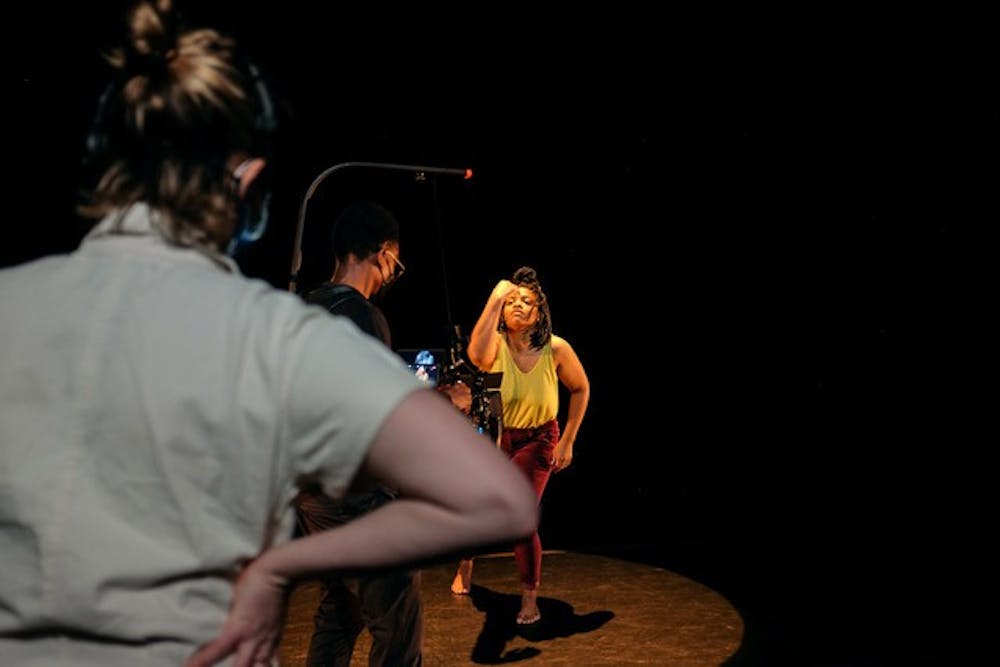“And there was already water there,” professor Britta Joy Peterson read in a calming voice from an essay she wrote.
Metaphors describing existence in her non-public essay, “Lapping Against the Shores of Attention,” would eventually inspire Peterson to name the immersive installation she directed called “already there.”
The Department of Performing Arts professor is an award-winning choreographer, who directed “already there” using her multifaceted background in the arts. Peterson created “already there” with a team of artists amid the coronavirus pandemic. The immersive installation was built so audiences could take away their own message from the piece that premiered at The Reach’s Studio K at the Kennedy Center.
Her knowledge in forms of dance, digital design and teaching skills helped her pick a team she could collaborate with, she said.
“It's a bit of a joke with some of my friends that I am a curator of souls,” Peterson said.
Peterson said her background allowed her to “speak the language” of every artist she worked with in “already there” to be a successful collaborator.
The installation’s music was composed by American University professor Sean Doyle and was a 25-minute experience enjoyed by small groups. Groups walked through hallways and rooms using the installation’s light, sound and projections of people dancing as their signals to move from one space to another.
Other members of Peterson’s team are a part of the AU community: three AU alumni — Olivia Webber, Dylan Lambert and Vyette Tiya — were involved in the production. Peterson said AU students are opinionated and want to contribute their ideas, which made them valuable to the project.
The project required dancers to be vocalists as well, which is not something all dancers can easily do, according to Peterson.
“They need to be not just interested in but invested in and experienced in collaboration,” Peterson said.
Peterson said she had the idea for “already there” starting in 2018, but the piece did not premiere until 2021 due to the pandemic. The installation showed Oct. 28-30 this year. Originally the work was designed for a 16-person performance ensemble that would use movements and sounds to captivate an audience but was changed into an immersive installation work.
“In this new world this installation, variation of the original ideas came into being,” Peterson said. “And frankly, it is better than the original idea.”
Peterson also added that the Kennedy Center is not known for installation style pieces. If she proposed her installation idea in 2018 to the Center she would have probably been denied, she said.
“Because of the circumstances, they find themselves in a place where they must be pliable, they must be receptive to different structures of performance,” Peterson said.
Dancers rehearsed in pods, everything was choreographed in groups of three and there was only one full group performance, according to Peterson. Due to COVID-19 considerations, everyone was filmed individually, edited and projected on the installation screens to look like movement was filmed together.
At one moment, audiences might experience visuals of dancers whose fluid movements match instrumentals playing, only to be interrupted by complete silence followed by sounds of the outdoors. At another point, audiences can expect to hear a fan blowing while watching a curtain bellow over a bench of grass they can sit on.
“It's like a carnival ride of sorts, or like a carwash for the senses,” Peterson said.
Because parts of the installation required audiences to walk through the installation, there were considerations about accessibility, Peterson said. She worked with a couple of consultants, one from Access Smithsonian and another from the Institute for Human-Centered Design, to make sure seating and other accessibility features were offered.
“already there” allowed audiences to use their own lived experiences as a tactic to filter out information to find personal meaning, according to Peterson. How one processes “already there” depends on influences ranging from religion to socio-economic background, Peterson said. She said she hopes to allow audiences to find their own meaning after processing the elements of the show.
“I can meaningfully contribute to this conversation without necessarily taking up space in a way that is oppressive,” Peterson said.





